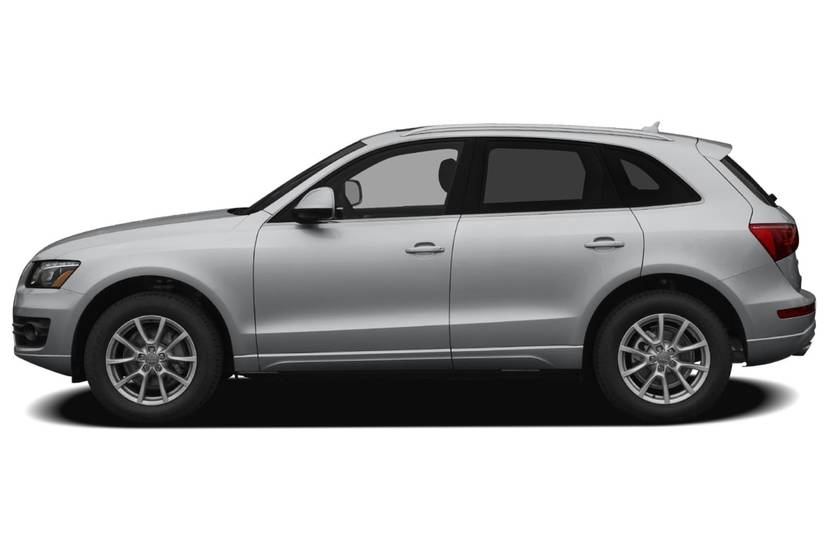
Many automakers abandoned their diesel plans in recent years as new-car sales tanked and diesel prices rose. Audi, however, has kept its diesel promises, which include a TDI clean-diesel version of its Q7 SUV, introduced in 2009.
The Q7 is a great fit for a diesel power plant; its excellent highway mileage is far above that of the gasoline Q7, plus the hefty SUV gets around easily with its massive amounts of diesel torque.
That said, though, while Audi has executed the Q7 diesel well, I’m not 100 percent convinced that diesel power is the way to go for every suburban family looking for a luxury SUV.
For 2010, the Q7 has Audi’s signature, eye-catching LED running lights available. As previous-model-year Q7 drivers passed me going the opposite direction, most gazed jealously at the 2010. Yes, the lights are that noticeable, and yes, they look that cool. To see the 2009 and 2010 Q7 compared, click here. To see our review of the 2009 Audi Q7 TDI, go here.
TDI Pros and Cons
So why offer a diesel engine in a family SUV? The TDI has the highest mileage ratings in the Q7 lineup at 17/25 mpg city/highway. That’s better than the gasoline six-cylinder (14/19 mpg) and eight-cylinder (13/18) offerings, but it’s not tops among luxury SUVs. The 2010 BMW X5 with a diesel engine is rated higher, at 19/26 mpg, and Mercedes-Benz’s ML 350 BlueTEC is comparable at 18/25 mpg. Mercedes’ larger GL 350 BlueTEC rates lower, at 17/23 mpg.
Diesel engines typically log their best fuel economy during highway driving. I pulled off higher-than-advertised mileage while cruising at around 45-55 mph, when 30 mpg was a familiar sight on the trip computer’s instantaneous mileage readout.
For those who don’t drive on the highway, the Q7 diesel’s appeal seems limited, considering its city mileage was never really impressive. Also, at 6,600 pounds, the maximum towing capacity isn’t any higher with the diesel than with a gasoline engine, though I suspect the towing experience would be different — possibly easier — with the diesel’s generous torque.
At the time I tested the Q7, diesel wasn’t any cheaper than gasoline. In fact, it was 25 cents more per gallon than regular, and equal to filling up with premium. The gasoline six-cylinder Q7 takes premium. Fueleconomy.gov estimates the annual fuel cost of the diesel Q7 to be $2,235 per year; the gasoline six-cylinder will cost $2,794 per year to fill up; and the eight-cylinder is projected to cost $2,981.
When it was time to fill up in my area — a large Chicago suburb — diesel stations weren’t along my normal commute. Having to go out of my way for go-go juice was another knock against the TDI. Again, this is situational; if you have a diesel station around the corner, then going diesel may be an easier transition. Even though I was driving in familiar areas, I quickly discovered I had no idea which stations carried diesel. Thankfully, Q7s equipped with the optional navigation system simplify the process with a diesel-station locator.
Then there are the little things about diesel ownership to consider — like, once you get to the station, you may be forced to sit in line behind a string of heavy-duty landscaping trucks, like I did. Oh, and you should also carry moist towelettes with you because diesel is very oily, and filling up often means leaving the pump a little dirtier than you were when you pulled in. And you don’t want to bring nozzle grease back into the Q7’s nice interior.
Diesel Driving
Driving the diesel was a joy most of the time. It has just 221 horsepower, but that number isn’t as important as the whopping 406 pounds-feet of torque, which moved the Q7 along effortlessly. I would actually call the diesel Q7 fun to drive — it’s at least fun to mash the accelerator pedal — if it weren’t for the inconsistent feeling of power. Sometimes when I goosed the car it accelerated almost surprisingly fast, and other times it would just fall on its face, feeling like a much less powerful vehicle.
To me, it felt like the six-speed automatic transmission could have kicked down another gear, but sometimes it just held the gear and slowly pulled away.
Interior & Cargo
For a three-row, seven-seat SUV, the Q7’s interior is on the smaller side, with only 104 cubic feet of passenger volume and 72.5 cubic feet of total cargo space. The small size is most apparent behind the third row, where there’s minimal cargo room. Plus, the third row itself is best suited for children. I’ll admit I’ve said that a lot when evaluating third rows, but it’s especially true in the Q7. I can typically fit in the third row of most vehicles and be OK for a short trip, but not in the Q7. At 6 feet tall, I couldn’t fit in the third row at all because of the extremely limited leg and headroom.
Our tester was loaded with options that gave some parts of the interior a very classy feel. The available Alcantara faux-suede headliner is something we don’t see very often, but it’s super ritzy when plastered across the ceiling. It was probably the nicest piece on the inside, considering that the steering wheel, door panels and dashboard materials weren’t anything special for an SUV that costs $76,000, as-tested.
I’m not saying the pieces looked cheap, but the 2011 Infiniti QX56 I recently drove put the Q7’s interior to shame. Every last piece on the inside of the QX’s interior was covered in leather: dashboard, center console, armrests, etc. The QX56 we drove was also less expensive, as tested, and immensely roomier in the second and third rows than the Q7. The QX56 has 174 cubic feet of passenger volume and 112.6 cubic feet of maximum cargo room, dwarfing the Q7.
Where the Q7 has its advantage is in its low-slung ride height, which provides easy entry, easy exit and easy cargo loading. With the optional air suspension, it can also be lowered closer to the ground for easier access, a function that can be controlled from either the control center up front or via buttons in the cargo area. Even at my height, I found the QX56 to be awkward to get into and out of because of its high ride height.
Features
You name it and the Q7 will likely have that feature available — which is why the price racks up so easily. To start off, all-wheel drive is standard. There’s an available adaptive air suspension with different ride height and firmness options, though the Q7 seemed to ride on the firm side regardless of suspension setting and didn’t have much cushioning over rough roads. The adaptive suspension costs $2,600 but also requires adding an expensive Prestige Package that costs a whopping $10,000.
Included in that package is a panoramic sunroof with a massive front window pane. Even the rear glass section pops up to a vent mode for rear passengers; most panoramic sunroofs offer fixed glass there.
The Prestige Package also equips the Q7 with Audi’s side-assist blind spot monitoring system and navigation system.
More options on our tester included a Warm Weather Package with four-zone climate control for the first and second rows; a Cold Weather Package with heated rear seats and a heated steering wheel; and a Luxury Package with the aforementioned Alcantara headliner and ventilated front seats. It’s quite the list, and altogether it bumps the Q7’s price up to just under $76,000. A federal diesel tax credit of $1,150 helps offset that cost a little, dropping the base MSRP of a Q7 diesel from $50,900 to $49,750.
A Bangin’ Good Time
I could easily forget about the diesel engine, Alcantara headliner, dynamic suspension and any other feature, though, because the optional Bang & Olufsen stereo was by far the most impressive option on the Q7. If you’re any kind of sound junkie or music lover, this stereo is worth the coin. Some may scoff at its $6,300 price, but on top of a $50,000 starting price, I wouldn’t think twice about checking this box.
It didn’t matter what type of music I piped through the speakers — the stereo filled every bit of space with rich sounds. It never felt like just a few of the speakers were doing the work, but that all of them were working together to make it one of the most enjoyable music experiences I’ve had in a car.
Audi Q7 in the Market
Having the diesel option gives Audi shoppers an alternative for great gas mileage, but it can’t escape the drawbacks that affect all diesel-powered new cars. Until diesel prices become more reasonable, the mileage advantage may not be enough to justify the cost and — for some — the hassle of buying a diesel SUV.
As for the Q7 itself, beyond its diesel power plant, it may be on the smaller side, but it doesn’t lack substance. It can be filled with feature on top of feature — though there aren’t any bargains to be found, as our test vehicle’s price reflects.













































